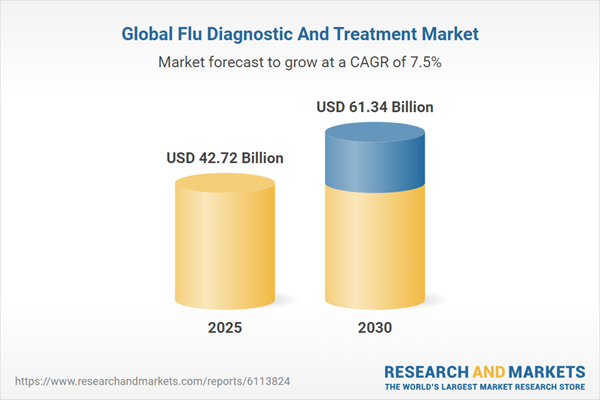The global flu diagnostic and treatment market is expected to experience significant growth over the next five years, driven by the high prevalence of influenza worldwide, particularly in regions with limited healthcare access. Rising investments in research and development by key market players to enhance product quality and expand offerings are anticipated to further propel market growth during the forecast period (2024-2029). The focus on improving health outcomes, especially for high-risk populations, underscores the market's expansion.
Key Growth Drivers
The increasing prevalence of influenza globally remains a primary driver of market growth. In North America, influenza A viruses dominate, accounting for approximately 80% of adult influenza-related hospitalizations. The growing incidence of flu in regions such as Europe and Asia Pacific also contributes significantly to market demand. The need for effective diagnostic and treatment solutions is amplified by the disease’s contagious nature, characterized by symptoms like fever, sore throat, dry cough, and muscle pain, which can lead to severe illness or death in vulnerable groups, including the elderly, pregnant women, infants, and immunocompromised individuals.The aging global population, particularly in countries like Japan, Italy, and Germany, further fuels market growth. Older adults, with weaker immune systems, require enhanced flu diagnostics and treatments, increasing demand for specialized kits and services. Well-established healthcare systems in these regions support the adoption of advanced diagnostic and treatment solutions.
Market Segmentation
By Flu Type
The market is segmented into Type A and Type B influenza viruses. Type A dominates due to its higher prevalence and greater number of clinically diagnosed cases and hospitalizations compared to Type B. The Type A segment is expected to maintain a significant market share through 2029. While Type B flu has a lower incidence, its growing prevalence, particularly in the Asia Pacific region, is anticipated to drive modest growth in this segment over the forecast period.By End-User
The market is categorized into hospital laboratories, outpatient clinics, and reference laboratories. Outpatient clinics are projected to exhibit notable growth due to their cost-effective, point-of-care treatment offerings. Hospital laboratories, however, are expected to retain a significant market share, driven by their ability to provide long-term care and perceived reliability. Reference laboratories also contribute to the market but to a lesser extent.Geographical Outlook
The Asia Pacific region is poised for robust growth, fueled by the rising prevalence of influenza in countries like India, China, and Indonesia, coupled with increasing healthcare expenditure in developing nations. North America is expected to maintain a substantial market share, supported by well-established healthcare systems in the U.S. and Canada and high healthcare spending. These factors collectively position North America and Asia Pacific as key regions driving the global flu diagnostic and treatment market through 2029.Key Benefits of this Report:
- Insightful Analysis: Gain detailed market insights covering major as well as emerging geographical regions, focusing on customer segments, government policies and socio-economic factors, consumer preferences, industry verticals, and other sub-segments.
- Competitive Landscape: Understand the strategic maneuvers employed by key players globally to understand possible market penetration with the correct strategy.
- Market Drivers & Future Trends: Explore the dynamic factors and pivotal market trends and how they will shape future market developments.
- Actionable Recommendations: Utilize the insights to exercise strategic decisions to uncover new business streams and revenues in a dynamic environment.
- Caters to a Wide Audience: Beneficial and cost-effective for startups, research institutions, consultants, SMEs, and large enterprises.
What do businesses use our reports for?
Industry and Market Insights, Opportunity Assessment, Product Demand Forecasting, Market Entry Strategy, Geographical Expansion, Capital Investment Decisions, Regulatory Framework & Implications, New Product Development, Competitive IntelligenceReport Coverage:
- Historical data from 2022 to 2024 & forecast data from 2025 to 2030
- Growth Opportunities, Challenges, Supply Chain Outlook, Regulatory Framework, and Trend Analysis
- Competitive Positioning, Strategies, and Market Share Analysis
- Revenue Growth and Forecast Assessment of segments and regions including countries
- Company Profiling (Strategies, Products, Financial Information, and Key Developments among others).
Global Flu Diagnostic and Treatment Market Segmentation:
By Type of Flu
- Type A
- Type B
- Others
By Offering
- Diagnostics
- Rapid Influenza Diagnostic Test
- Rapid Molecular Assay
- RT-PCR & NAATs
- Immunofluorescence Assays
- At-Home Flu Testing Kits
- Therapeutics
- Antiviral Medications
- Vaccines
- Others
By Age Group
- 0-14 Years
- 15-64 Years
- >=65 Years
By Mode of Administration
- Oral
- Intranasal
- Injectable
By End-User
- Hospitals & Hospital Laboratories
- Outpatient Clinic
- Pharmacies & Retail Clinics
- Reference Laboratories
- Home Care/Self-Test Users
By Geography
- North America
- USA
- Canada
- Mexico
- South America
- Brazil
- Argentina
- Others
- Europe
- Germany
- France
- United Kingdom
- Spain
- Italy
- Others
- Middle East and Africa
- Saudi Arabia
- Israel
- UAE
- Other
- Asia Pacific
- China
- Japan
- South Korea
- India
- Thailand
- Indonesia
- Taiwan
- Others
Table of Contents
Companies Mentioned
- QuidelOrtho Corporation
- F. Hoffmann-La Roche AG
- Becton, Dickinson and Company
- Thermo Fisher Scientific Inc.
- SA Scientific, Ltd.
- Sekisui Diagnostics, LLC
- Meridian Bioscience, Inc.
- Oxford Biosystems Ltd.
- Pfizer Inc.
- Bayer AG
- GlaxoSmithKline plc
- Abbott Laboratories
- Danaher Corporation
- Sanofi S.A.
- Hologic, Inc.
- Luminex Corporation
- DiaSorin S.p.A.
Table Information
| Report Attribute | Details |
|---|---|
| No. of Pages | 148 |
| Published | June 2025 |
| Forecast Period | 2025 - 2030 |
| Estimated Market Value ( USD | $ 42.72 Billion |
| Forecasted Market Value ( USD | $ 61.34 Billion |
| Compound Annual Growth Rate | 7.5% |
| Regions Covered | Global |
| No. of Companies Mentioned | 17 |









